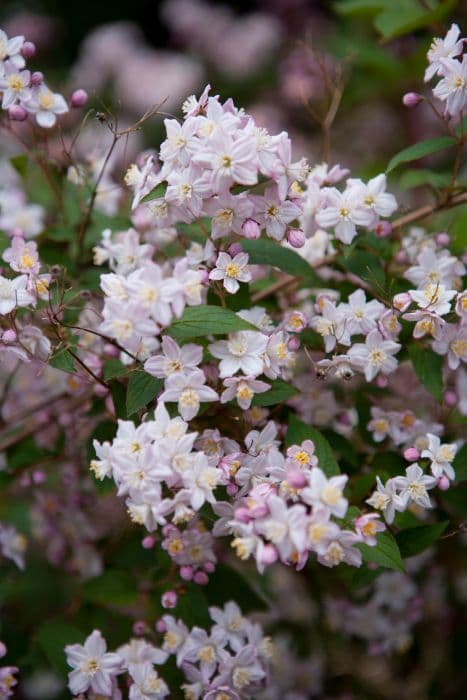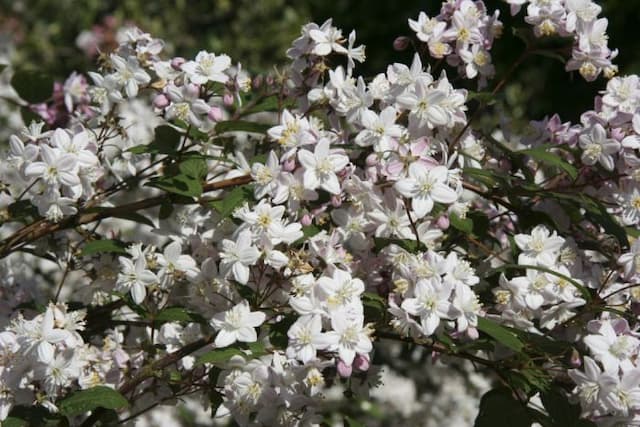Hydrangea serrata 'Rosalba' (L)

ABOUT
The Hydrangea serrata 'Rosalba' is a captivating shrub known for its beautiful, ornate flowers and lush foliage. This variety boasts a mound of deep green leaves which provide a striking backdrop for its blooms. The leaves can have a slight serration along the edges, hinting at a textured appearance that adds depth to the plant's overall look. The standout feature of 'Rosalba' is its flowers, which emerge as delicate, lacecap inflorescences, a term that describes the flat, disk-like shape of the flower clusters. These flowers display a two-toned effect: at the center, tiny, less showy fertile flowers give a subtle grace, while the outer edge is adorned with larger, sterile flowers that carry the more typical "hydrangea" appearance. The sterile flowers often have soft pink petals, but they can take on different hues depending on the soil pH, with more acidic conditions leading to bluer tones, and alkaline soils leaning towards pinks and reds. When it blooms, the plant becomes a focal point in the garden, with the flowers adding a significant visual impact. They appear in profusion, creating a lush and romantic appeal. Even as the flowers age, they continue to provide interest, often drying on the plant and segueing into muted color tones that are appealing even as the growing season fades. In addition to its stunning flowers, this hydrangea may experience a change in leaf color during autumn, when the greens may shift to attractive shades of red or burgundy, contributing to its overall charm throughout the growing season.
About this plant
 Names
NamesFamily
Hydrangeaceae
Synonyms
Mountain Hydrangea, Tea of Heaven
Common names
Hydrangea serrata 'Rosalba' (L).
 Toxicity
ToxicityTo humans
Hydrangeas, including Hydrangea serrata 'Rosalba', can be toxic to humans if ingested. The plant contains compounds that release cyanide when chewed or digested. This can potentially lead to cyanide poisoning. Symptoms of hydrangea poisoning may include gastrointestinal upset, such as vomiting and diarrhea, along with more serious signs like dizziness, rapid pulse, drop in blood pressure, and in severe cases, convulsions and respiratory failure. The highest concentration of these toxic compounds is typically found in the leaves and buds of the plant.
To pets
Hydrangeas, including Hydrangea serrata 'Rosalba', are also toxic to pets and can cause similar symptoms of poisoning as in humans. If ingested, pets may experience vomiting, diarrhea, lethargy, and depression. The toxic principle is the same as it is in humans, the compound that can release cyanide into the body. In severe cases, ingestion could lead to increased heart rate, increased body temperature, seizures, and even coma. It is advised to seek veterinary care immediately if a pet has ingested parts of a hydrangea plant.
 Characteristics
CharacteristicsLife cycle
Perennials
Foliage type
Deciduous
Color of leaves
Green
Flower color
Pink
Height
2-6 feet (0.6-1.8 meters)
Spread
2-6 feet (0.6-1.8 meters)
Plant type
Shrub
Hardiness zones
6
Native area
Japan
Benefits
 General Benefits
General Benefits- Aesthetic Appeal: Hydrangea serrata 'Rosalba' adds visual interest to gardens with its attractive pink-to-blue flowers, depending on soil pH.
- Landscape Diversity: This plant can be used in a variety of garden designs, including borders, foundation plantings, and as specimen plants.
- Seasonal Interest: It provides seasonal color and can be a focal point in the garden during its blooming season in late spring to summer.
- Pollinator Friendly: Attracts bees and other pollinators, which are essential for the health of the garden and the environment.
- Shade Tolerance: This variety is suitable for partly shaded areas, expanding landscaping options in gardens with varying light conditions.
- Hardiness: It is a hardy plant that can withstand cold temperatures, making it a robust addition to many gardens.
 Medical Properties
Medical Properties- This plant is not used for medical purposes.
 Air-purifying Qualities
Air-purifying QualitiesThis plant is not specifically known for air purifying qualities.
 Other Uses
Other Uses- Floral displays: Hydrangea serrata 'Rosalba' can be used for creating stunning dried flower arrangements, as the blooms retain their shape and color well when dried.
- Fabric dye: The leaves and blooms can be used to create a natural dye for fabrics, yielding shades of blue and purple depending on the pH of the water used during the process.
- Artisan crafts: The woody stems can be incorporated into intricate plant-based crafts, such as miniature trellis designs or woven decorations.
- Garden design: The plant's compact growth habit makes it suitable for use in Japanese-style garden designs or as part of a bonsai arrangement.
- Seasonal markers: The changing bloom colors can serve as a natural indicator of soil pH levels in the garden throughout the seasons.
- Photography subject: The striking flowers make this plant a favored subject for photographers, particularly macro photography enthusiasts.
- Culinary decoration: Edible flowers from this plant can be used to adorn desserts and drinks, although they do not add any particular flavor.
- Cultural symbolism: In some cultures, Hydrangea serrata 'Rosalba' is associated with heartfelt emotions and gratitude, making it appropriate for gifting on special occasions.
- Educational tool: The plant's sensitivity to soil pH can be utilized in educational settings to demonstrate chemistry in nature and the influence of pH on flower coloration.
- Color indicator in crafts: Petal pigments can be used in pH indicator strips for crafters who work with pH-sensitive materials and need a natural indicator.
Interesting Facts
 Feng Shui
Feng ShuiThe Mountain Hydrangea is not used in Feng Shui practice.
 Zodiac Sign Compitability
Zodiac Sign CompitabilityThe Mountain Hydrangea is not used in astrology practice.
 Plant Symbolism
Plant Symbolism- Heartfelt Emotions: Hydrangea often symbolizes heartfelt and sincere emotions, due to its lush and abundant star-shaped flowers which can evoke a sense of abundance and generosity.
- Gratitude: The extravagant and showy nature of the blooms can also be representative of gratitude, making it a perfect gift to express thanks.
- Frigidity or Heartlessness: In some Victorian symbolism, the hydrangea could sometimes imply a cold or frigid heart, likely due to the plant's earlier names and its ability to withstand harsh conditions.
- Boastfulness: The lavish round flower heads may symbolize boastfulness or vanity, as they can be seen to show off their beauty without restraint.
- Understanding: The diverse color range and sensitivity of hydrangeas to soil pH is indicative of understanding and being able to see from different perspectives.
 Water
WaterThe mountain hydrangea, also known as Hydrangea serrata 'Rosalba', prefers consistently moist soil, so it should be watered thoroughly once a week or more frequently during hot, dry weather. It's important to avoid letting the soil dry out completely between waterings. Each watering should provide enough water to soak the soil around the roots; this typically means using approximately 1 to 2 gallons for outdoor plants, depending on the size of the plant and environmental conditions. During the winter or in cooler climates, water less frequently, but ensure the hydrangea doesn't dry out completely. Always use room temperature water to avoid shocking the plant's roots.
 Light
LightFor optimal growth, the mountain hydrangea should be situated in a location that receives morning sun and afternoon shade. Direct afternoon sunlight can be too intense and may cause the foliage to burn, so a spot that gets dappled sunlight throughout the day or light shade is ideal. A north or east-facing garden spot that avoids the harsh afternoon sun is perfect for this plant.
 Temperature
TemperatureThe mountain hydrangea thrives in a range of temperatures but prefers a cooler climate with temperatures ranging between 60 to 75 degrees Fahrenheit. While it can tolerate occasional dips down to about 5 degrees Fahrenheit, prolonged exposure to temperatures below this range may damage the plant. The ideal temperature conditions avoid extremes, providing a moderate climate that supports healthy growth without putting stress on the hydrangea.
 Pruning
PruningPruning mountain hydrangeas should be done to maintain shape and remove any dead or damaged branches, which encourages healthy growth and abundant blooms. It's best to prune immediately after flowering, as this plant blooms on old wood. Cut back just above a pair of healthy buds, and aim to remove no more than one-third of the plant at a time to avoid stressing it. Removing spent flower heads can also promote a tidier appearance.
 Cleaning
CleaningAs needed
 Soil
SoilMountain Hydrangea 'Rosalba' prefers moist, well-draining soil with high organic content. A good mix might consist of equal parts garden soil, peat moss, and perlite. The soil pH should be acidic, ideally between 5.5 and 6.5, to maintain the pinkish hue of the blooms.
 Repotting
RepottingMountain Hydrangeas such as 'Rosalba' typically require repotting every 2-3 years to refresh the soil and accommodate root growth. It's best done after flowering or in early spring before new growth begins.
 Humidity & Misting
Humidity & MistingMountain Hydrangea 'Rosalba' thrives in environments with high humidity, ideally between 60% and 70%. Consistent humidity helps ensure healthy growth and vibrant blooms.
 Suitable locations
Suitable locationsIndoor
Place 'Rosalba' in bright, indirect light and maintain high humidity.
Outdoor
Plant 'Rosalba' in partial shade with moist, well-drained soil.
Hardiness zone
6-9 USDA
 Life cycle
Life cycleHydrangea serrata 'Rosalba', commonly known as the Mountain Hydrangea, begins its life cycle as a seed, which requires cold stratification to stimulate germination. Once germinated, it enters the seedling stage and starts to develop roots and foliage, establishing itself as a young plant. As it matures, it enters the vegetative stage, expanding its root system and producing lush green leaves. During the flowering stage, typically in early summer, the Mountain Hydrangea produces delicate white to pink lace-cap flowers that attract pollinators and may shift in color depending on the soil pH. Once pollinated, the flowers give way to seeds, which will disperse to perpetuate the next generation of hydrangeas. After flowering, the plant enters a period of dormancy in the winter; it sheds its leaves and conserves energy to survive the cold until it can resume growth in the spring.
 Propogation
PropogationPropogation time
Spring to early summer
The Hydrangea serrata 'Rosalba', commonly known as the mountain hydrangea, is commonly propagated through softwood cuttings. The ideal time for this method is late spring or early summer when the plant is actively growing and the new stems are mature enough yet still flexible. To propagate, a 4 to 6-inch cutting should be taken from a healthy branch, making sure it includes several sets of leaves. The lower leaves are removed, and the cut end is dipped in rooting hormone to encourage root development. The cutting is then planted in a mix of moist peat and perlite, with the remaining leaves above the soil line. The cutting should be kept in indirect light and maintained with consistent moisture, and roots typically develop within a few weeks to a couple of months.







![Hydrangea [Early Sensation]](/_next/image?url=https%3A%2F%2Fplants-admin.emdemapps.com%2Fimages%2Fplants%2F%2Fimages%2F604b6150338db.png&w=640&q=75)

